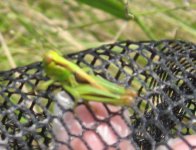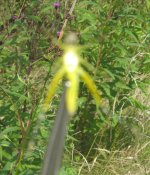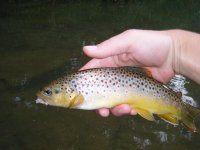Fishing with grasshopper patterns, although it’s never caught on in PA to the extent it does in the West every year, can be pretty productive and has it share of fans….especially in the Cumberland Valley. I always have some hopper patterns and use them both as “floats” for scuds and midges but also to match the hatch in late summer. Last year and this summer, perhaps due to warm dry weather, hoppers seem particularly numerous.
Out of curiosity, I decided this summer to do an entirely unscientific survey of hoppers along a meadow bordering Falling Springs. I’ve always enjoyed rock rolling - Why not try out catching terrestrials to see what they look like? On a sweltering day earlier this month (Aug 8th), I hit the meadow with butterfly net and clipboard. Unfortunately, most of the dozen or so pics I took did not turn out – perhaps due to the sweat running down my glasses - so I’ve posted only three.
Some general observations: The average size of the hoppers I gathered was just under an inch. My guess would be that, in part, this was due to the ease of catching instar bugs (young versions without fully formed wings). The meadow was just teeming with hoppers (lots of very small crickets too). There were larger hoppers but the smaller ones were much more numerous. I’d imagine by late Sept the average size will have increased as hoppers grow through the mid summer to autumn period.
From a fly tying standpoint, the coloration was interesting. I’m not sure of the species but suspect that many of the bugs I saw were of the Two Striped Grasshopper species(?). The colors varied greatly but the underside of almost all the hoppers was either green or light brown. The green bugs outnumbered the brown ones by slightly over half. Those with green undersides were all fairly bright with many having a brilliant, almost lime green color. The brown bellied bugs were more muted – most of them resembled in tone the color of a milkshake. Other colors existed but these greens and light browns were the overwhelming majority. Leg colors usually matched the body, but many had orange legs.
Anyway, for what it’s worth, if you’re planning on tying any hoppers, esp for a visit to Falling Springs, you might consider flies about an inch in length tied with a bright green body.
Out of curiosity, I decided this summer to do an entirely unscientific survey of hoppers along a meadow bordering Falling Springs. I’ve always enjoyed rock rolling - Why not try out catching terrestrials to see what they look like? On a sweltering day earlier this month (Aug 8th), I hit the meadow with butterfly net and clipboard. Unfortunately, most of the dozen or so pics I took did not turn out – perhaps due to the sweat running down my glasses - so I’ve posted only three.
Some general observations: The average size of the hoppers I gathered was just under an inch. My guess would be that, in part, this was due to the ease of catching instar bugs (young versions without fully formed wings). The meadow was just teeming with hoppers (lots of very small crickets too). There were larger hoppers but the smaller ones were much more numerous. I’d imagine by late Sept the average size will have increased as hoppers grow through the mid summer to autumn period.
From a fly tying standpoint, the coloration was interesting. I’m not sure of the species but suspect that many of the bugs I saw were of the Two Striped Grasshopper species(?). The colors varied greatly but the underside of almost all the hoppers was either green or light brown. The green bugs outnumbered the brown ones by slightly over half. Those with green undersides were all fairly bright with many having a brilliant, almost lime green color. The brown bellied bugs were more muted – most of them resembled in tone the color of a milkshake. Other colors existed but these greens and light browns were the overwhelming majority. Leg colors usually matched the body, but many had orange legs.
Anyway, for what it’s worth, if you’re planning on tying any hoppers, esp for a visit to Falling Springs, you might consider flies about an inch in length tied with a bright green body.










